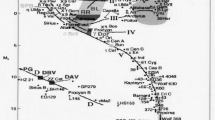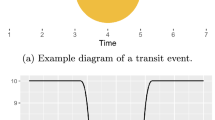Abstract
At present, autonomous management and operation of spacecraft are the main direction and objective of the development of space technology to lighten the burden of ground measurement and control, reduce the cost of operation and management, and expand the application scope of spacecraft. To select the suitable periodic variable stars with a certain quantity at the given conditions of spacecraft, we study the autonomous navigation method of optical variable spacecraft and propose a feature selection model to filter periodic variable stars with light-variable characteristics. It mainly focuses on the learning processes of the pulsating optical variable light variation star clock model, the high precision pulsating optical variable autonomous navigation algorithm and the optical variable light variation characteristic mechanism with the measurement method. From experiments, the sample of the periodic variable star is selected, forms a database of 132 initial candidate samples and 16 navigation sample stars. So, time measurement can be conducted to take advantage of the nature of periodic variable stars that take days as its cycle, ground-based observation and ground-based application can be conducted with the wide spectrum of periodic variable star observation. It can meet the requirements of spacecraft.





Similar content being viewed by others
References
Chory, M.A., Hoffman, D.P., & LeMay, J.L. (1986). Satellite autonomous navigation status and history[A]. In Proceedings of IEEE position location and navigation symposium[C]. (pp. 110–121). Las Vegas.
Battin, R.H. (1987). An introduction to the mathematics and methods of astrodynamics[R]. American institute of aeronautics and astronautics inc.
Sarivastava, S. (1984). Autonomous stationkeeping system for the lincoln experimental satellite (LES) 8 and 9 [R]. AIAA-1984-1861.
Zhang, P., Gu, J., Milios, E.E., & et al. (2005). Navigation with IMU/GPS/digital compass with unscented Kalman filter[C]. In IEEE International conference mechatronics and automation, 2005(Vol. 3, pp. 1497–1502). IEEE.
Wang, B., Ren, Q., Deng, Z., & et al. (2014). A self-calibration method for nonorthogonal angles between gimbals of rotational inertial navigation system[J]. IEEE Transactions on Industrial Electronics, 62(4), 2353–2362.
Battin R.H. (1987). An introduction to the mathematics and methods of astrodynamics[R]. American institute of aeronautics and astronautics, Inc.
Gai, K., Qiu, M., & Zhao, H. (2016). Security-aware efficient mass distributed storage approach for cloud systems in big data [C]. In 2016 IEEE 2nd international conference on big data security on cloud (BigDataSecurity), IEEE international conference on high performance and smart computing (HPSC), and IEEE international conference on intelligent data and security (IDS) (pp. 140–145).
Qiu, M., Jia, Z., Xue, C., & et al. (2007). Voltage assignment with guaranteed probability satisfying timing constraint for real-time multiproceesor DSP [J]. The Journal of VLSI Signal Processing Systems for Signal, Image, and Video Technology, 46, 55– 73.
Qiu, M., Zhang, K., & Huang, M. (2004). An empirical study of web interface design on small display devices [C]. In IEEE/WIC/ACM International conference on web intelligence(WI 2004) (pp. 29–35).
Gai, K., Qiu, M., Zhao, H., & Sun, X. (2018). Resource management in sustainable Cyber-Physical systems using heterogeneous cloud computing [J]. IEEE Transactions on Sustainable Computing, 3(2), 60–72.
Dai, W., Qiu, L., Wu, A., & Qiu, M. (2018). Cloud infrastructure resource allocation for big data applications [J]. IEEE Transactions on Big Data, 4(3), 313–324.
Zhu, M., & et al. (2016). Public vehicles for future urban transportation [J]. IEEE Transactions on Intelligent Transportation Systems, 12(17), 3344–3353.
Bhaskaran, S., Riedel, J.E., Kennedy, B., & Wang, T.C. (2002). Navigation of the deep space 1 spacecraft at borrelly [A]. AIAA-2002-4815.
Godsill, S.J., Doucet, A., & West, M. (2004). Monte carlo smoothing for nonlinear time series [J]. Journal of the American Statistical Association, V99(465), 156–168.
Gipsman, A., Guelman, M., & Kogan, A. (1999). Autonomous navigation and guidance system for low thrust driven deep space missions [J]. Acta Astronautic, V44(7-12), 353–364.
Massimiliano, V., Fabio, S., & Franco, B.Z. (2002). Deep space autonomous orbit determination using CCD [A]. AIAA-2002-4818.
Yim, J.R., Crassidis, J.L., & Junkins, J.L. (2004). Autonomous orbit navigation of two spacecraft system using relative line of sight vector measurments [A]. AAS-04-257.
Andrews, S.F. (2002). Recent flight results of the TRMM kalman Filter[A]. AIAA-2002–5047.
Kasdin, N.J., & Haupt G. T. (1997). A second order control and numerical considerations for the two-step optimal estimator[J]. Journal of Guidance, Correction, and Dynamics, V20(2), 362–369.
Crassidis, J.L., Alonso, R., & Junkins, J.L. (2000). Optimal Attitude and Position Determination from Line-of-Sigh Measurements [A]. AAS-00-268.
Truong, S.H. (2001). A robust and Self-Tuning kalman filter for autonomous spacecraft navigation [D]. Doctor Degree Thesis, George Washington University.
Busse, F.D., & How, J.P. (2002). Real-time experimental demonstration of precise decentralized relative navigation for formation flying Spacecraft[A]. AIAA- 2002–5003.
Crassidis, J.L., & Markley, F. L. (2003). Unscented filtering for spacecraft attitude estimation [J]. Journal of Guidance Control, and Dynamics, V26(4), 536–542.
Oshman, Y., & Filter, C.A. (2006). Attitude estimation from vector observation using genetic-algorithm-embedded quaternion particle [J]. Journal of Guidance Control, and Dynamics, V29(4), 879–891.
Huang, D.L., & Leung, H. (2005). An expectation-maximization-based interacting multiple model approach for cooperative driving systems[J]. IEEE Transaction on Intelligent Transportation Systems, V6(2), 206–228.
Author information
Authors and Affiliations
Corresponding author
Additional information
Publisher’s Note
Springer Nature remains neutral with regard to jurisdictional claims in published maps and institutional affiliations.
Rights and permissions
About this article
Cite this article
Chen, J., Tang, G. A Feature Selection Model to Filter Periodic Variable Stars with Data-sensitive Light-variable Characteristics. J Sign Process Syst 93, 733–744 (2021). https://doi.org/10.1007/s11265-021-01637-3
Received:
Revised:
Accepted:
Published:
Issue Date:
DOI: https://doi.org/10.1007/s11265-021-01637-3




